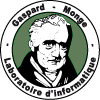Pixel-accurate road crack detection in presence of inaccurate annotations
Résumé
Recent road crack detection methods obtain appealing scores but typically allow a few pixel tolerance margin. This is acceptable for locating cracks, but not for measuring their width (indicator of the cracks’ severity). Our baseline model, U-VGG19, obtains an F-score of 71.77% on CrackForest, which is superior to other approaches when no tolerance is admitted. However, increasing the scores without tolerance is difficult due to inaccurate annotations. We propose a novel synthetic dataset, Syncrack, as a benchmark for the evaluation of training with inaccurate annotations. Our results show that inaccurate annotations have a detrimental impact on the F-measure, decreasing it by up to 20%. To overcome this, we study label noise correction techniques using weakly supervised learning. Training U-VGG19 with these corrected labels improves the results on Syncrack by up to 12%. Obtained results on the CrackForest and Aigle-RN datasets support that these approaches are useful for real-life data too.
| Origine | Fichiers produits par l'(les) auteur(s) |
|---|



